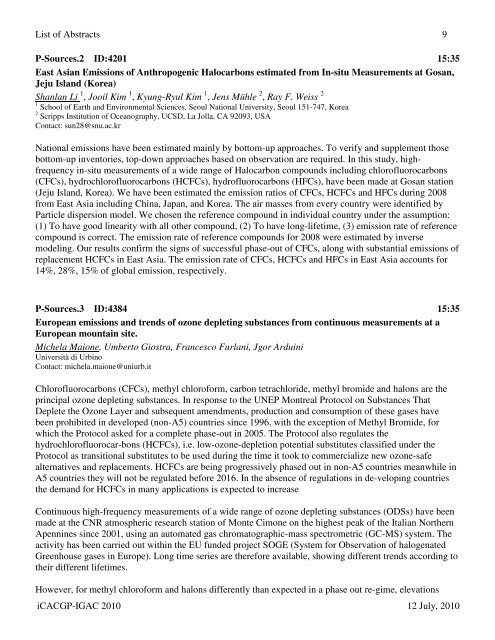Download Abstracts Here - IGAC Project
Download Abstracts Here - IGAC Project
Download Abstracts Here - IGAC Project
Create successful ePaper yourself
Turn your PDF publications into a flip-book with our unique Google optimized e-Paper software.
List of <strong>Abstracts</strong> 9P-Sources.2 ID:4201 15:35East Asian Emissions of Anthropogenic Halocarbons estimated from In-situ Measurements at Gosan,Jeju Island (Korea)Shanlan Li 1 , Jooil Kim 1 , Kyung-Ryul Kim 1 , Jens Mühle 2 , Ray F. Weiss 21 School of Earth and Environmental Sciences, Seoul National University, Seoul 151-747, Korea2 Scripps Institution of Oceanography, UCSD, La Jolla, CA 92093, USAContact: sun28@snu.ac.krNational emissions have been estimated mainly by bottom-up approaches. To verify and supplement thosebottom-up inventories, top-down approaches based on observation are required. In this study, highfrequencyin-situ measurements of a wide range of Halocarbon compounds including chlorofluorocarbons(CFCs), hydrochlorofluorocarbons (HCFCs), hydrofluorocarbons (HFCs), have been made at Gosan station(Jeju Island, Korea). We have been estimated the emission ratios of CFCs, HCFCs and HFCs during 2008from East Asia including China, Japan, and Korea. The air masses from every country were identified byParticle dispersion model. We chosen the reference compound in individual country under the assumption:(1) To have good linearity with all other compound, (2) To have long-lifetime, (3) emission rate of referencecompound is correct. The emission rate of reference compounds for 2008 were estimated by inversemodeling. Our results confirm the signs of successful phase-out of CFCs, along with substantial emissions ofreplacement HCFCs in East Asia. The emission rate of CFCs, HCFCs and HFCs in East Asia accounts for14%, 28%, 15% of global emission, respectively.P-Sources.3 ID:4384 15:35European emissions and trends of ozone depleting substances from continuous measurements at aEuropean mountain site.Michela Maione, Umberto Giostra, Francesco Furlani, Jgor ArduiniUniversità di UrbinoContact: michela.maione@uniurb.itChlorofluorocarbons (CFCs), methyl chloroform, carbon tetrachloride, methyl bromide and halons are theprincipal ozone depleting substances. In response to the UNEP Montreal Protocol on Substances ThatDeplete the Ozone Layer and subsequent amendments, production and consumption of these gases havebeen prohibited in developed (non-A5) countries since 1996, with the exception of Methyl Bromide, forwhich the Protocol asked for a complete phase-out in 2005. The Protocol also regulates thehydrochlorofluorocar-bons (HCFCs), i.e. low-ozone-depletion potential substitutes classified under theProtocol as transitional substitutes to be used during the time it took to commercialize new ozone-safealternatives and replacements. HCFCs are being progressively phased out in non-A5 countries meanwhile inA5 countries they will not be regulated before 2016. In the absence of regulations in de-veloping countriesthe demand for HCFCs in many applications is expected to increaseContinuous high-frequency measurements of a wide range of ozone depleting substances (ODSs) have beenmade at the CNR atmospheric research station of Monte Cimone on the highest peak of the Italian NorthernApennines since 2001, using an automated gas chromatographic-mass spectrometric (GC-MS) system. Theactivity has been carried out within the EU funded project SOGE (System for Observation of halogenatedGreenhouse gases in Europe). Long time series are therefore available, showing different trends according totheir different lifetimes.However, for methyl chloroform and halons differently than expected in a phase out re-gime, elevationsiCACGP-<strong>IGAC</strong> 2010 12 July, 2010








